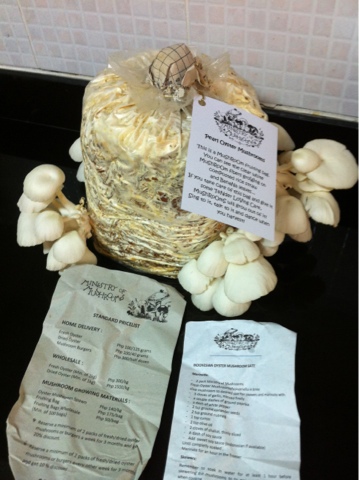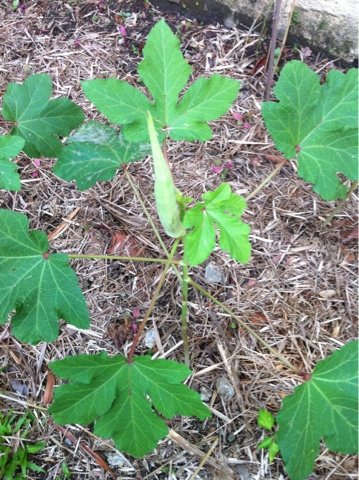While it seems my mushroom bin went rank due to moisture pooling in the bottom of the container, the larvae that I had once worried were not black soldier fly appear now to be black soldier fly. I'm not 100% certain - heck, I'm not 100% certain about many things - but they do seem to have taken on the proper form of BSF.
My dear mushroom contacts over at Ministry of Mushrooms came through for me today with some spawn to pick me up from being morose about a failed first mushroom experiment. One kilogram of oyster mushroom grain spawn to experiment with on my coir! Next, I'll have to purchase a pressure cooker...
Sustainability and good governance... with a little bit of bioremediation mixed in.
The Green Gap
In the Cold War, we feared a Missile Gap was a strategic weakness. Nowadays, we must awaken to the fact that the Green Gap is true strategic weakness: the nations whose economies will thrive in the coming years will not be those with the biggest factories, but those with the most sustainable, efficient, and ecological markets. What we require is a Strategic "Green Reserve" of ecological design to weather the coming changes that both climate and resource scarcity will force on the international economy.
Saturday 26 May 2012
Sunday 20 May 2012
More Mycelial Love
It appears the mycelium is taking to the coir substrate, with the moist coffee grounds maintaining the humidity of the mix notably high. It appears almost as if the coffee grounds are doing double duty, as they can be metabolised by the mycelium and they provide an obvious amount of moisture: obvious by the waft of moist air I get when I pop open the container. Let's see where this goes!
Thursday 17 May 2012
Mycelium Running?
The title of this post is, of course, a riff on Stamets' great work Mycelium Running, one of the three inspirational treatises by Stamets I'm working from. The others are Growing Gourmet and Medicinal Mushrooms and The Mushroom Cultivator. I say "inspirational" in part because they are inspirational, but also in part because I'm not doing anything Stamets really recommends. However, after pasteurising my bulk substrate of coir, palm fronds, and coffee grounds, I appear to have mycelium running!!
Saturday 12 May 2012
Phase three... or is it five? Mushrooms.
Got a fruiting bag of mushrooms to provide mycelium for a clone. The guys at the Ministry of Mushrooms at Saturday's Salcedo market are pretty awesome and helpful. I've now got a pot to sterilise my bulk substrate, some coir, some leaves, and I think I'm ready to go.
Friday 11 May 2012
Treats for the Maggots
I hear Black Soldier Fly larvae like coffee grounds. My friends at the neighbourhood Starbucks obliged me with a metric assload of coffee grounds, some of which I intend to use in bulk substrate for growing mushrooms, some for my BSFL. The BSFL are quite active - today I found a couple on the roof of the bin and a couple on the walls. The reports I had heard from other tropical BSFL ranchers that they have incredible climbing abilities when the walls of the bin are wet appear to be substantiated. Now, to use that to my advantage in self-harvesting...
You can see the great, big, fat and happy larvae on my trowel there in the picture on the right. There is an incredible amount of size variance amongst the larvae, and these were easily 1cm long and perhaps 3mm-4mm wide. Many are still tiny. Just from observation, the fat ones are found in the vicinity of meat and the skinny ones seem to be found around vegetables, so I imagine the BSFL have sublimely fast metabolisms and their growth is only limited by the amount of protein they can find in their environment. I learn more every day.
In other news, the coconut guy came today to hack down some coconuts for us. I had one to celebrate. Deeeeee-licious. Of course, I saved the husk to dry for coir.
I gotta admit, I really have this wonderful sense of not knowing what the hell I'm doing, but truly enjoying just trying stuff out and seeing what works. The main thing is that I'm not throwing all this stuff in the garbage. It will go back into the land, somehow.
Thursday 10 May 2012
Affnan's Aquaponics
This man is my hero. His experimentation into siphons (and his incredible explanation of siphon optimisation) is breathtaking.
Black Soldier Fly
I've been trying to attract black soldier fly larvae (BSFL) for some time now. First, I started with rotten coconut. That dried out, moulded, and ended out nasty and disgusting. I then tried reconstituting corn, putting it in the coconut to rot, and attracting BSFL that way. The corn moulded and ended up not being colonised. Finally, I had some old cabbage pickles that were going rancid in the fridge. I put those in the coconut and kept them wet but under a cover. After a week or two, I spotted what I believe to be BSFL. since then, I've gotten a bucket and started feeding them outside the coconut. While they've not completely colonised the bucket, they are slowly eating our biodegradables. See disgusting picture below :) (the BSFL are the white things in the middle of the bottom third of the picture)
Of course it doesn't disgust me, I'm the proud father of highly useful maggots :)
Of course it doesn't disgust me, I'm the proud father of highly useful maggots :)
Thursday 3 May 2012
Mulching
Here is a shot of some okra in the home-made mulch from our shredder.
Mulching, of course, is highly useful. In our case, we have a confluence of two very important factors that make me believe mulching is an optimal practice for our yard. First, it's the dry season. Mulching helps in moisture retention. I dropped this mulch down after a (very rare!) summer rain. Second, our garden is full of palm trees that are regularly shedding lower leaves in their constant struggle to beat other plants to the canopy. This, combined with sticks I steal from the neighbours' garbage heap, coconut husks, and leaves from the bamboo stand, makes a great and varied texture mulch - and keeps that valuable carbon in our ecosystem. Tropical ecosystems seem to shed carbon like mad, but in a natural tropical ecosystem, the decomposers are totally on steroids - they break stuff down real fast. In the gardens in this part of the world, all the hired gardeners are told to do is get rid of the detritus and make it look presentable. The garden slowly sheds all its nutrients and carbon to the garbage heap, leaving a nasty, hard soil. I'm trying to stem that tide and keep the good stuff where it belongs...
...and stealing other people's good stuff from their garbage. Let's face it, I have no shame.
Subscribe to:
Posts (Atom)




